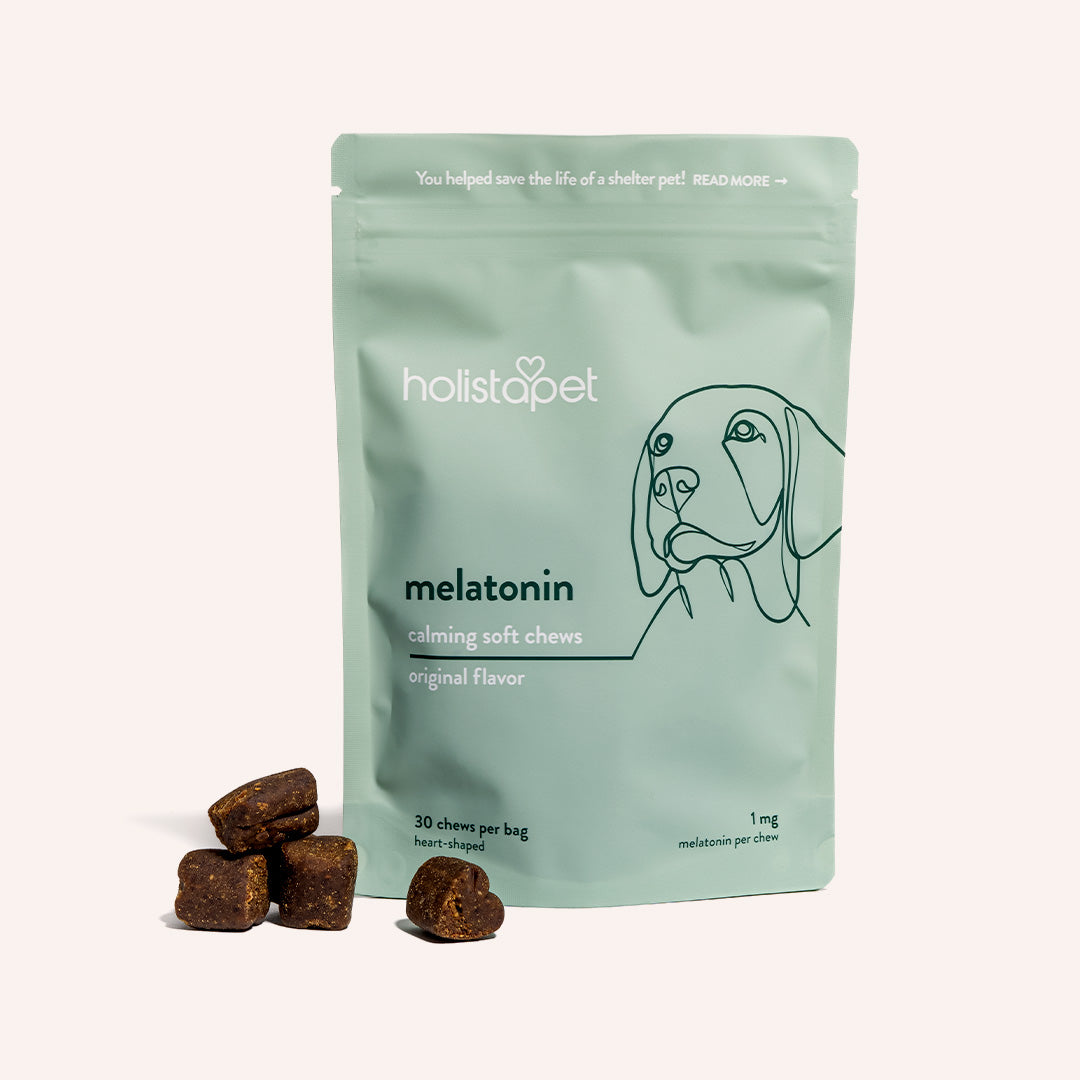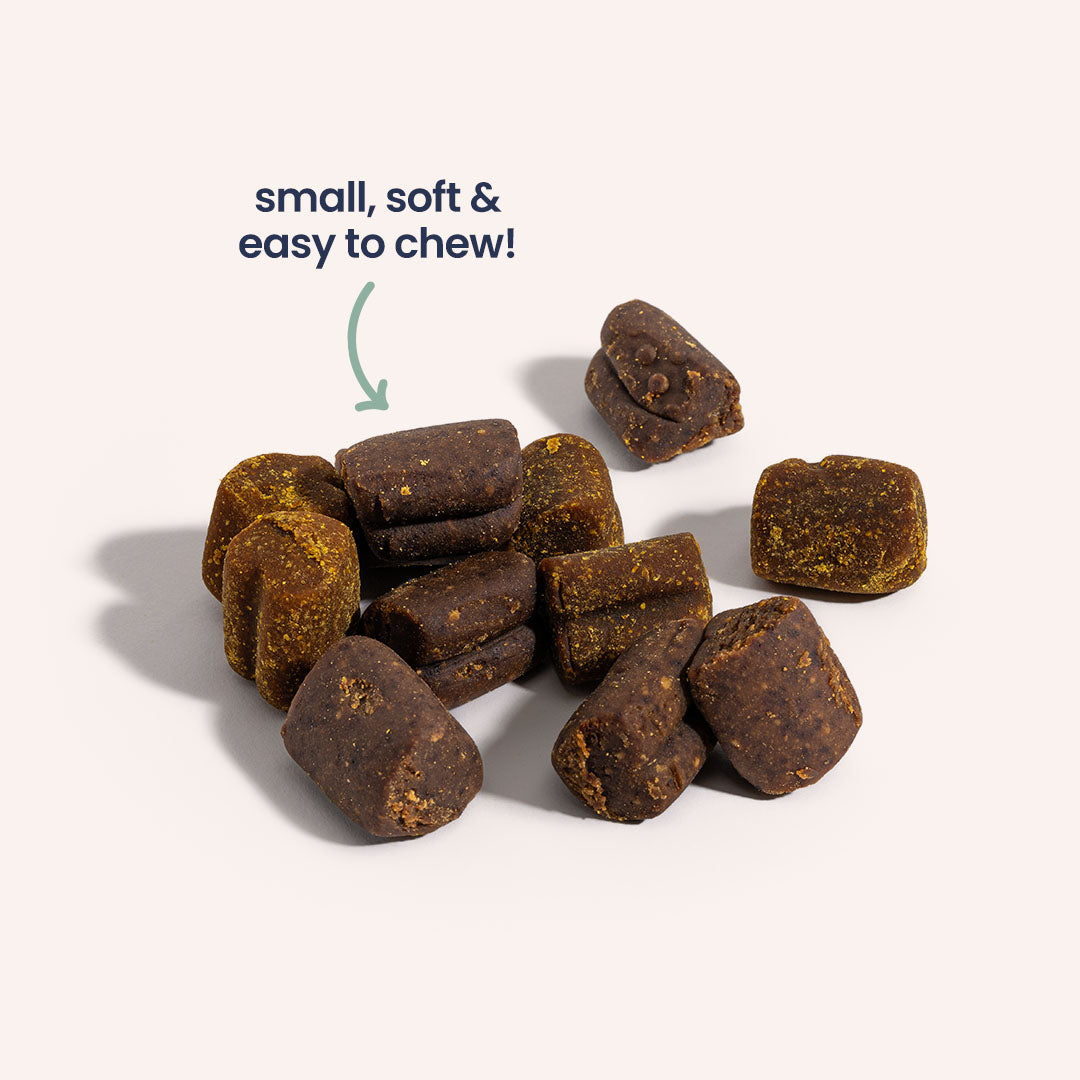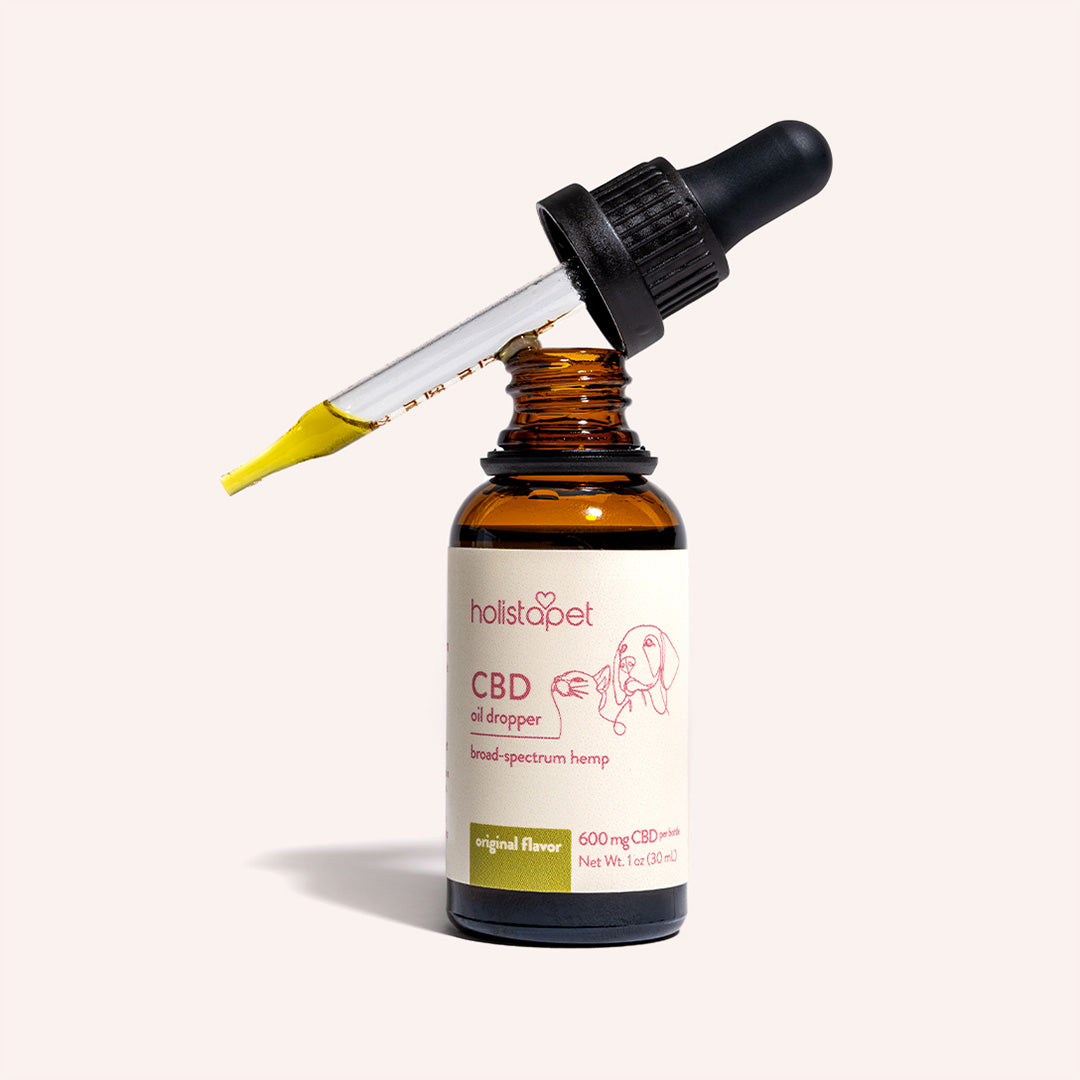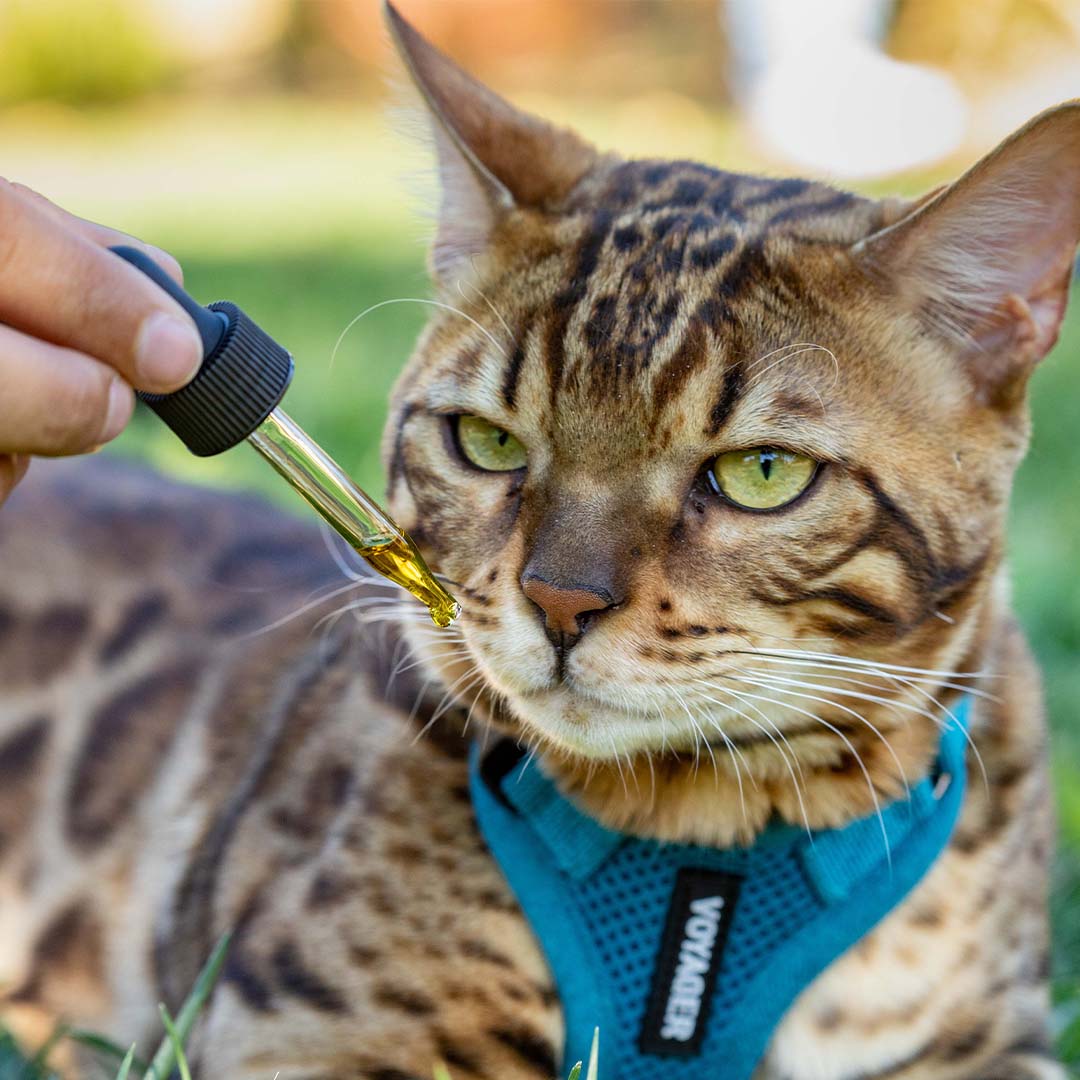Let’s face it, dogs can be a real handful at times. As much as we love them and their boundless energy, it can be tough to rein them in. More likely than not, we’ve all seen a hyper pooch wreck furniture, tear up the garden, and jump all over everyone. There are many ways to calm an energetic dog; some are more natural than others. So, how can you naturally calm a hyper dog? Many owners find success by creating structure and stimulating their dog’s mind, along with plenty of exercise and natural supplements chamomile.
How Can You Tell If Your Dog Is Hyper?
First, it’s important that we take a moment to define some terms. Hyper is shorthand for hyperactivity. Excess energy may be normal for a dog's age and breed, but some dogs' overactivity can be due to abnormal conditions such as anxiety or hyperkinesis. Famed animal behaviorist, Karen Overall writes in her book Clinical Behavioral Medicine for Small Animals that actual clinical hyperactivity, sometimes referred to as hyperkinesis, is fairly rare.
Your dog may be suffering from hyperkinesis if you see all of the following symptoms:
- Frenetic activity
- Impulsive behavior, such as the inability to turn off play when the ball goes away
- Inability to relax completely, even when the environment is quiet and familiar
- Being overly reactive to regular stimuli, such as food, noises, or people
- An inability to focus on any task and a concise attention span
- Physiological symptoms like elevated heart rate and heavy breathing, even when not active
Hyperkinesis is the canine form of human ADHD! However, it’s more likely that your dog is hyperactive due to an energetic personality or possibly anxiety. Regardless of the root cause, hyperactivity can be frustrating, so let’s examine some things you can do to counter this exhausting behavior and calm your hyper dog.
Why Are Some Dogs So Hyper?
It’s important to understand genetics and environment play a role in all types of dog behavior too, including hyperactivity. However, hyperkinesis is a congenital condition that must be diagnosed and treated by a veterinarian. In other words, hyperkinetic dogs seem to be born with this abnormality and it requires fairly hyperactive dog treatment with amphetamine-type drugs along with behavior modification. Interestingly, these are precisely the same hyper dog medication used in humans.

However, the other reasons for a hyper dog are more varied, including:
The Dog’s Individual Personality
There are just some dogs that are bursting with energy, while other ones are lazy all day, every day. Ultimately, most dogs will mellow with age, but their current surplus of puppy energy may prove difficult for you as a pet owner.
Stress
Nervous behaviors can be defined as negative anticipation or worrying about an event. Many dogs hesitate when anxious, but it is important to recognize that other dogs may react with increased fidgeting, such as pacing, scratching, sniffing, panting, jumping, or acting “stubborn,” which is really an inability to focus on their owners or task. It can be challenging to distinguish anxious energy from the other types because the source of the anxiety is not always present or accessible for the owners to identify.
External Stimuli
If a dog has too little or too much stimulation, it can go a little stir-crazy. Ultimately, you want to provide your dog with enough activity to keep them occupied but not so much that they become frustrated or overly tired. Like human toddlers, overtired dogs can paradoxically show hyperactive behavior.
Not Enough Physical Activity
This is enormously important; remember, while dogs are great additions to our families, they are still animals with the instinct to search and hunt. Genetically speaking, they’re not very far from wolves and therefore have the urge to spend much of their day seeking out their meals. By confining dogs to houses, even with yards, and placing all their food in bowls, we limit the exercise of their body and minds.
Type of Breed
Additionally, the type of breed is also crucial. Let’s take a moment to list the 15 most hyper breeds according to AKC.org, in alphabetical order:
- Australian Shepherd
- Beagle
- Border Collie
- Dalmatian
- English Springer Spaniel
- German Shepherd
- Golden Retriever
- Irish Setter
- Labrador Retriever
- Miniature Pinscher
- Pembroke Welsh Corgi
- Poodle
- Russel Terrier
- Shetland Sheepdog
- Siberian Husky

Do you notice any similarities? Well, they’re all working dogs! That means their original purpose was to perform a very active job, often for long periods. Most of those jobs were related to highly physical tasks, such as herding, hunting game, retrieving, sled-pulling, and so on. Although statistically, very few individual dogs perform these activities in modern Western culture, genetics has not caught up, and the dogs still have tons of energy that used to be devoted to these jobs.
5 Ways How To Calm A Hyper Dog Naturally
So now that we’ve established the different causes of hyperactivity, how do you calm a hyper dog down? This question is crucial because most dogs have normal or mildly stressed hyper behavior. Remember, clinical hyperactivity, or hyperkinesis, in dogs is exceedingly rare – much rarer than, say, ADHD in humans. But what are the ADHD dogs natural treatment? So, let’s go over five ways to calm a hyper dog down.
#1 Exercise Releases Energy
This is a big one; exercise will go a long way in calming your hyper dog down. A long walk in the morning, anywhere from 30 to 60 minutes, and then a shorter one in the evening, 15 to 30 minutes, is the minimum time for most healthy dog's mental exercise, regardless of breed. In a pinch, breaking aerobic activity into multiple short bursts throughout the day will also work.
#2 Create Structure and Predictability
A source of stress can be not knowing what to expect. Create routine and predictability by building some basic structure in your dog’s daily activities and, even more importantly, in how you interact with your dog. A commonly used technique to help you with this is asking your dog to perform a simple task before being given any resource.
For example, ask for a simple “sit” before affection from you, access to furniture, toys, or food. There is no need to be a stern drill sergeant. If your dog doesn’t sit, the resource isn’t granted. Set your rules about this and calmly stick to them. Getting angry often backfires and escalates tensions.
#3 Use Obedience/Training to Calm a Hyper Dog
Think about what you would like the dog to do when it is annoying you or acting out of control. Go to her crate? Sit on a dog bed across the room? Ensure this is a reliable cue when the dog's brain is calm. A good dog trainer, such as a Certified Pet Dog Trainers Association (CPDT-KA) member, can help with this. Any reward-based training improves your bond with your dog and increases the chances she will listen to you in stressful or hyper moods.

#4 Toys/Puzzles Stimulate the Mind
Food puzzles provide outlets for chewing, physical and mental, stimulation. Get puzzle toys like Kongs, Bob-a-lots, or Buster Cubes, fill them with your dog’s food, and then have them manipulate the toy to get a little piece of food. These will keep your dog occupied much longer than bowl feeding, and work out some of that excess energy!
#5 Supplements Can Calm a Hyper Dog
What are the medicine for hyper dogs? There are many calming supplements/treats on the market, but the most promising ones are cannabidiol (CBD). When CBD interacts with dogs' cannabinoid receptors, it helps to support their endocannabinoid system. This system regulates many of their bodies' functions, including the nervous system, which is how CBD can assist in naturally calming pups.
By administering an appropriate dose to your hyperactive dog, they can reap the calming benefits of CBD — we suggest between 0.25 mg (regular dose) to 0.5 mg (strong dose) of CBD per every 1 lb. of bodyweight.
Aside from more traditional crunchy dog treats, many other effective CBD products for dogs are on the market! Products can include:
- Chewy soft treats for older dogs or those with sensitive tummies or teeth
- CBD oil tincture, which can be administered directly or added to food or water
- Hemp powder capsules which are pre-dosed and very portable for those who like to go on adventures
- Topical products, like salves or CBD shampoo for dogs
- And more!
Common natural ingredients in CBD pet treats include flaxseed and hemp seed powder. Along with being great for dogs' bodies and overall nutritional health, these active ingredients also work with CBD to help your pup relax, along with many other calming agents. We've listed some of the most common calming agents in dog-calming supplements and broken down how they can help below!
Related Post: How to Get a Dog to Sleep Through the Night
L-Theanine
L-theanine is an amino acid commonly found in fungal plant species, like tea or mushrooms! Studies have shown that L-theanine can help those who struggle with insomnia, anxiety, and other stressors. It's also been proven to help boost overall immunity, reduce inflammation, encourage proper digestion, and more.
Valerian Root
Valerian root, which contains valeric acid, has been used to help with sleep for centuries—and by centuries, we mean as early as 500 B.C.! Early records from Greek physicians Hippocrates and Galen show that valerian root was used to help treat insomnia. Though it has been used to treat many other ailments through time, it's most known for its tranquilizing and calming properties.
Chamomile
Though chamomile is most commonly found in tea, its compounds can be isolated and formulated for many uses. From eye infections to sciatica, this herb has been hailed for its healing abilities for thousands of years. One of the chamomile's most well-known benefits is its ability to aid anxiety or those struggling with insomnia or other sleep disturbances. No wonder pet companies love using it in food and treats to help boost pet wellness!
L-Tryptophan
Did you know that your body can turn L-tryptophan into serotonin and melatonin? This amino acid is crucial to the body and helps make proteins and other essential chemicals that can help regulate things like mood patterns and sleep cycles. Unfortunately, mammal bodies cannot create tryptophan on their own — that's why ensuring it's included in our pets' (and our own) diets is so important.
Passionflower
Passionflower (or P. incarnata) is a vining plant that produces vibrant, purple flowers. Originally used by Native Americans, more recent studies have shown its ability to help with anxiety, sleep troubles, and various stomach issues.
#6 Don't Motivate Or Encourage Excitement
When dogs are excited, it can be tempting to greet their enthusiasm with lots of love, pets, and affection. Unfortunately, this encourages feeding your dog's hyper behavior. By petting them and giving them words of affirmation when they jump on you or run around you in circles, you're telling them that their unwanted behaviors are good and that they should do them more often.

Instead of accidentally rewarding your dog when they're overly excited, try ignoring them until they calm down — this means no talking or addressing them! Once they've calmed down, you can greet them and give them as many pets as possible.
#7 Reward And Encourage Calm Behavior
One of the easiest ways to teach your dog to continue behaving calmly and collectedly is to reward them when they're relaxed. Instead of giving your dog lots of attention when they're hyper, try showing them the most affection when calm. This will reinforce their calm behavior and teach them that they'll be rewarded if they continue to behave that way.
Treats can also be beneficial when training your dog through positive enforcement! We suggest keeping a bag of CBD Dog Treats + Calming Relief nearby so that you can reward your pup for their best behavior.
#8 Provide Calming Scents
Did you know that a dog's brain's primary sense is its sense of smell? Unlike humans, who only have 5 million nose receptors, dogs have about 220 million receptors. By engaging your dog's nose receptors through nose work, you can help ease their nerves and calm them into a more relaxed mood. Try associating different calming scents with calm areas of the house (for example, near where they sleep, if they have a crate they spend time in throughout the day, in your bedroom, etc.).
By doing this, you'll be able to help calm your dog down by exposing them to the scent. If you're unsure what scents to start with, a 2018 study found that vanilla, ginger, coconut, and valerian root all "have significant positive effects on stress indicators in dogs." Whether you use air fresheners, dryer sheets, perfumes, or essential oils, these scents will help your dog unwind.
Alternatively, if you don't want to purchase a scented product, try using an old pajama shirt to help ease your pup. You are your dog's best friend and protector, and your scent is familiar at home. By giving them an article of clothing or blanket that smells like you, you're likely to help them feel more comfortable wherever they are — whether in the car, at the vet's, in a traveling crate, or any other spot that may make them feel unease.

Disclaimer About Essential Oil Usage
It's important to note that some essential oils are toxic to pets. Oils like cinnamon, peppermint, pine, sweet birch, ylang-ylang, citrus, pennyroyal, tea tree, and wintergreen can cause adverse reactions if ingested or placed on a pet's body. We highly recommend researching scented products before buying anything new for your pup so you will only purchase pet-safe items. If you're unsure about whether a scent will be safe for your dog, give a call to your vet or another licensed healthcare professional.
#9 Be Calm Around Your Dog
Are you an excited or loud person? Do you often respond to your dog's excitement by shouting? If so, it's possible that this could be contributing to your dog's hyperactivity. When dogs are shouted at, it can increase their excitement rather than help them to relax. And when your dog is performing an action you don't like — bouncing off the walls, jumping up at you, or begging — you want to be able to stop them quickly and efficiently, not encourage them.
One of the best ways to form good dog training habits is using firm, short commands. Dogs can only register so many syllables at a time, so shorter commands like "no," "stop," "wait," or "hold" are easier for them to understand and remember. Dogs also remember gestures well! One great way to utilize commands and gestures in training is by teaching and practicing when walking with your dog.
Before crossing a street with a stop sign, try holding your arm out in front of your dog and firmly telling them to "wait" before allowing them to "go" when it's safe. They'll soon associate an outward arm with "waiting" and recognize how they should behave when they see that physical command. Remember that dogs are pack animals, so how you behave around them will influence their responses to you!
Can I Use Melatonin To Calm My Hyper Dog
While melatonin can help calm your dog, severe symptoms can occur due to overuse. It's unlikely that your dog can overdose on melatonin. Still, they may experience vomiting, diarrhea, heavy drowsiness, insulin resistance (in dogs with diabetes), trouble with digestion, and even increased heart rate. Because of this, you must reach out to a vet before deciding to give your dog melatonin.
Before choosing to use melatonin, there are other kinds of products available that may help calm your dogs and help them achieve a better night's rest:
- CBD oil tinctures: Broad-spectrum oil tinctures can be easily added to your dog's food bowl or given directly to help a high-energy dog calm down more quickly. Along with CBD, it contains beneficial terpenes, and the oil dropper makes dosing much more accessible!
- CBD hemp extract capsules: These small capsules contain CBD and hemp seed powder. They're super portable and can be hidden within a treat or popped open to be mixed in with food.
At HolistaPet, we carry CBD Oil for Dogs and cats and CBD Capsules for Dogs and cats, along with many other CBD treats that can help any active dog have a more laid-back day. Check out our shop to see what else we have for hyper dogs!
Applying Multiple Strategies
Implementing these five strategies is an excellent way to calm your dog down. Furthermore, you can also adhere to the American Kennel Club’s concept of STAR, which they use to educate dog owners on how to raise dogs best. STAR is an acronym that stands for:
- Socialization
- Training
- Activity
- Responsible owner
This entire STAR philosophy can be helpful when dealing with a hyper dog. Granted, it won’t singlehandedly solve the problem, but if adequately integrated with the five tips above, you may end up with a calm, collected, and relaxed dog. Don’t give up hope; there is help for almost any hyperactive dog. Read more here.
Final Thoughts
Hyperactive dogs can sometimes be cute, but they can be difficult to manage more often than not. Fortunately, there are many ways to calm hyper dogs! Whether through mental and physical exercise, puzzle toys, training time, implementation of supplements or tasty CBD treats, or a combination of methods, no hyper pup has to remain hyper forever.
Are you a dog owner looking to help your pup burn off some excess energy? HolistaPet's Blog for helpful tips, tricks, and practices. Or check out these guides for any other breed you're interested in.








![Probiotics For Dogs [Soft Chews]](http://www.holistapet.com/cdn/shop/files/Probiotic-Infographic-1_472d7a29-e30c-435a-9638-1365d8c3a9f9.jpg?v=1725384841&width=104)


















![Puppy Growth Chart [Stages of Growth + How To Determine Ideal Size]](http://www.holistapet.com/cdn/shop/articles/254.jpg?v=1715222167&width=500)












Leave a comment
This site is protected by hCaptcha and the hCaptcha Privacy Policy and Terms of Service apply.